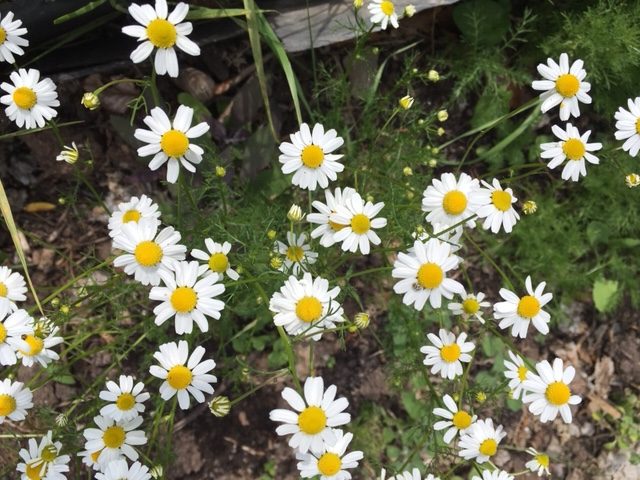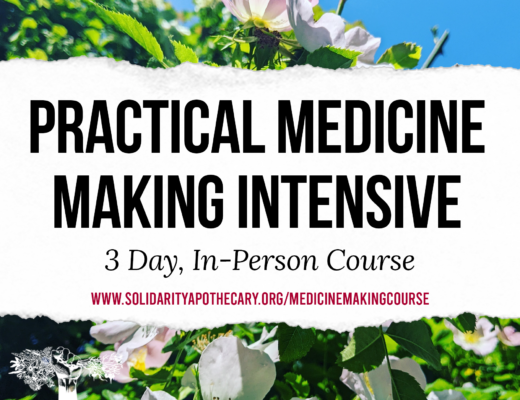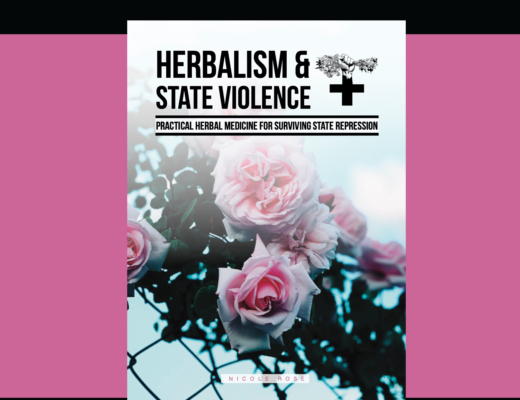Please note these plant profiles are a work in progress. I will always be adding to them as I keep learning about the amazing world of plant medicine.
Botanical Overview
Latin name: Chamaemelum nobile (Roman chamomile), Matricaria chamomilla (German Chamomile), Matricaria discoidea (Wild chamomile/Pineapple weed)
Plant family: Asteraceae
Identification:
- German chamomile – this is an annual plant that self-seeds. It can grow10-80cm high. It has white flowers with a yellow disk in the middle surrounded by evenly spaced white florets. It generally flowers in June and July and smells pleasant and sweet.
- Roman chamomile – this is the chamomile which is very low growing at only 6-10cm. It is a perennial. The flowers are smaller than the German chamomile.
- Wild chamomile/Pineapple weed – Low-growing hairless herbs with leaves deeply and intricately cut into very thin lobes, the main lobes divided further into smaller ones (2-pinnate) which themselves can be divided (3-pinnate). (1) It has a strong pineapple smell. The flower heads are 30-45mm across with yellow centres and no white petals.
Other species: Corn chamomile (Anthemis arvensis) has no scent. Scentless chamomile or Sea Mayweed (Tripleurospermum inodorum) is found at the seaside.
Folk names in English: Maythen, Manzanilla, Whig Plant, Ground Apple. The Latin name is derived from the Greek ‘khamaelon’ meaning ‘earth apple’.
Chemical constituents:
- German chamomile: terpenoids (α-bisabolol, α-bisabolol oxide A and B, chamazulene) sesquiterpenes; coumarins (umbelliferone); flavonoids (luteolin, apigenin, quercetin); patuletin; spiroethers: en-yn dicycloether and other components such as tannins, anthemic acid, choline, polysaccharides and phytoestrogens
- Roman chamomile are terpenoids: chamazulene, bisabolol; flavonoids: quercetin, apigenin, luteolin; coumarins: scopoletin-7-glucoside and other components like angelic and tiglic acid esters, anthemic acid, fatty acids and choline(2)

Food and nutrition
Chamomile is used as a flavouring agent in alcohol beverages, bitter tonics and teas. It has also been used to flavour desserts and sweets. Herbalist Mark Pedersen writes that tests show chamomile is commonly high in fat, magnesium, phosphorous, riboflavin and sodium and very high in niacin (3).
Ecological role
Chamomile is often found on well-drained soil on waste ground and around field margins. You can find chamomile across Europe and temperate Asia and North Africa, as well as some parts of Australia and Argentina. Chamomile was also used as a strewing herb in the Middle Ages to help keep insects away. They were hung in bundles or placed on the floor and in furniture. Chamomile is commonly grown and imported from Bulgaria, Germany, Italy, France, Greece, Hungary and Egypt.
Cultivation: Medicinal herb growers Jeff and Melanie Carpenter say “Chamomile likes full sun and well-drained sandy loam with good fertility and organic matter. This annual will readily self-seed, however, self-seeded beds are often interspersed with weeds that chamomile will not out-compete. This can be problematic and make harvesting difficult. For production, it is good to start with a weed-free seedbed and replant each season.” They recommend broadcasting the seed in autumn or early spring at 4-16 ounces per acre. If you’re growing on a smaller scale then sprinkle on seed trays and do not cover as the seeds require light to germinate (4).

Energetics
- Temperature: Cooling
- Moisture: Dry
- Tissue State: Wind/Tension, Heat/Excitation
- Taste: Aromatic, Bitter, Sweet
Health challenges supported by Chamomile:
Chamomile has a very long history of traditional use in every region it is found. It was also one of the nine sacred herbs of the Anglo-Saxons.
Herbal actions: Analgesic, anti-anaemic, anti-inflammatory, anti-parasitic, antiseptic, antispasmodic, bactericidal, calming, carminative, cholagogue, cicatrisant, digestive, emmenagogue, febrifuge, hepatic, hypnotic, immuno-stimulant, nerve sedative, ophthalmic, stomachic, sudorific, tonic, vermifuge, vulnerary (5).
Nervous system: Chamomile is a mild to moderate nervous sedative. It can help us switch from a sympathetic to the parasympathetic nervous system state. It will help calm the nervous system and relax the muscles. It can also really help with troubled sleep that is attributed to restlessness.
Indigestion: ‘Indigestion’ is a bit of a catch-all phrase for a variety of digestive system complaints including belching, bloating, gas etc. Herbalist Sajah Popham says “Chamomile is unique in the way it contains both bitter compounds as well as aromatic volatile oils, which leads to a nice combination of our two primary digestive actions. Thus we see an increase in gut secretions, local circulation to the digestive organs, and an overall relaxant/antispasmodic effect.” (2) Herbalist David Hoffman writes “Because Chamomile is rich in essential oil, it acts on the digestive system, promoting proper function, this usually involves soothing the walls of the intestines, easing griping pains, and facilitating the elimination of gas. A cup of hot chamomile tea is a simple, effective way to relieve indigestion, it calms inflammations, such as gastritis and helps prevent ulcers.” (6) Chamomile can also help with stomach aches, nausea, heartburn, loss of appetite, diarrhoea and constipation.

Ulcers: Ulcers are sadly all too common in our stressed-out world. These include stomach ulcers (peptic ulcers), small intestine ulcers (duodenal ulcers) and in the oesophagus. They are often caused by the prolonged use of NSAIDs (non-steroidal anti-inflammatory drugs such as ibuprofen), as well as food allergens irritating the gut. Sajah says chamomile helps via its vulnerary and inflammation modulating properties as well as gently helping to support digestion.
Joint pain and skin conditions: These can be helped by applying diluted chamomile essential oil topically. Chamomile has a stunning blue essential oil that is high in chamazulene and azulene. It can be diluted and used topically for conditions like rosacea, eczema, and psoriasis to bring symptomatic relief. It can also be used for rheumatoid arthritis, rheumatic pain and fibromyalgia. When I was unwell with costochondritis (inflammation in the cartilage of the ribs), I would use chamomile essential oil with coconut oil and rub it all over my ribs as I was going to bed. It helped me fall asleep when I was in a lot of pain and also reduced the inflammation. Joint pain and skin inflammation can also be relieved by adding a chamomile infusion into your bathtub or making and using a compress on the sore area.
Gum problems: A mouth rinse of chamomile tea can help with gingivitis as well as other gum inflammations and sores in the mouth.
Fungal infections: Chamomile can help internal and topical fungal infections. Topical applications, including poultices and baths, can help with skin rashes and inflammation, including those from fungus. I once had an acute fungal infection in my toenail while on a speaking tour that affected my ability to walk. The people where I was staying didn’t have many herbs but they did have chamomile tea bags, so I made a very strong infusion with lots of bags and gave myself an impromptu foot bath. I also wrapped the nail with the garlic and oil and thankfully it healed up quite fast. My friends were surprised that my embarrassing limp went overnight!
Pink eye: Sajah writes how chamomile can be useful for pink eye and conjunctivitis), “Chamomile is very helpful by either applying a tea bag topically on the eye (only used once – meaning one tea bag for each eye), or making a tea with a bag or loose tea (straining it really well ) can be used as an eyewash for conjunctivitis. The tea can be applied by dipping a cotton ball into tepid cooled tea and applied by wiping from the inner eye to the outer eye in one sweep. When this is done, make sure to discard the cotton ball after each eye and be sure to wash hands in between.”

Pre-menstrual tension: Chamomile can be a really great ally for people who menstruate who would like some relief from nervousness, tension, irritability and all the other feelings before coming on! It can help calm folks down but can also support by dispersing stagnation and draining fluids which will help ease menstrual pain. It can also act as an emmenagogue to help bring on bleeding.
Upper respiratory tract infections: Conditions such as bronchitis, catarrh, asthma and spasmodic coughing can all be helped by chamomile. These conditions are best helped with steam inhaled through the nose and mouth. Sajah says, “The mucous membranes of the mouth, sinus, throat and lungs all benefit from the oils within Chamomile, fighting off invading pathogens and helping to sooth the tissue and heal the mucosa, and reducing inflammation. It has been used as an old treatment for hay fever.”
Haemorrhoids: Chamomile can be added to a sitz bath to help cool down itchy irritated haemorrhoids.
Children’s complaints: Chamomile is super safe for children which makes it a very well used remedy. For fevers, it can be combined with peppermint and lemon balm. It’s also good for colic and diarrhoea. Overall it can also just help an irritable child chill out due to its action on the nervous system. For teething, a traditional remedy is soaking a cloth in the tea or infusion, letting it cool and then applying it to the sore area. A cloth can also be soaked and then put in the freezer to become a freezable chew that the baby can chew on for relief. Chamomile has also been made into all sorts of gels for teething kids, as well as creams and ointments for nappy rash. Be aware that children will need less than adults.
Hair care: For folks with blonde or golden hair, chamomile been used as a hair wash to keep hair light.
Cautions: Do not take during pregnancy. Be careful using in therapeutic doses in combination with orthodox anticoagulants. Sajah says “Caution with CNS depressants, such as opiates, alcohol, benzodiazepines tricyclic antidepressants, anaesthetics, or anti-epileptics. Avoid with Warfarin and related anticoagulant medications. Avoid if allergic or sensitive to aster-family plants.”
Chamomile and the Solidarity Apothecary
Chamomile will be featured in my upcoming Prisoner’s Herbal book. Chamomile tea is a great herb for anarchist folks who often have quite ‘hot’ constitutions who find it difficult to relax. It’s support for the immune system also make it an ally for frontline organisers.
Sources
1. Plants and Habitats, Ben Averis
2. Chamomile monograph, Materia Medica Monthly produced by the Sajah Popham at the School of Evolutionary Herbalism
3. Nutritional Herbology, Mark Pedersen
4. The Organic Medicinal Herb Farmer, Jeff and Melanie Carpenter
5. Chamomile monograph, The Plant Medicine School
6. The Holistic Herbal, David Hoffman




